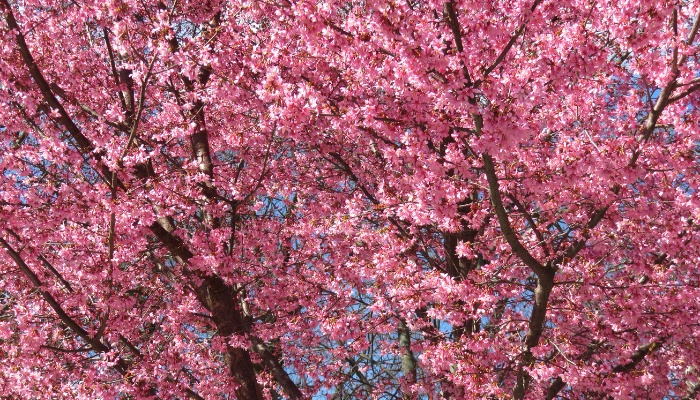The Okame cherry tree is known for its stunning appearance, with its thick clusters of vibrant pink flowers making it a tough competitor in terms of beauty.
Naturally, this variety is a very popular choice with home gardeners, and if you’re thinking of planting your own, you may be wondering how fast you can expect them to grow.
The Okame cherry tree grows at a fairly moderate rate, achieving about 1 to 2 feet each year. It takes the Okame variety around 7 to 10 years to fully mature. By this time it will have attained a maximum height and spread of roughly 20 feet on average.
The happy pink flowers are merely the icing on the canopy, so to speak. This ornamental cherry tree also wows with stunning fall colors and intriguing bark for year-round appeal.
To nurture a healthy Okame cherry tree, keep reading for tips on everything from pruning and choosing the right location to encourage bountiful blooms and more!
Sure, the Okame cherry tree is a great choice, but there are so many other beautiful options to discover. You can learn about the most popular ornamental cherries in my article Best Flowering Cherry Tree Varieties.
Okame Cherry Tree
Commonly nicknamed ‘Taiwan Cherry’, the Okame Cherry tree was developed by 20th-century British ornithologist and plant collector Collingwood ‘Cherry’ Ingram, a known authority on Japanese flowering cherries.
Ingram’s goal was to develop a cherry tree with the carmine-pink flowers of the native Taiwan Cherry tree with a higher tolerance to cold. Let’s learn more about its hardiness, rich coloring, and more.
| Botanical name | Prunus ‘Okame’ |
| Mature height | 20-30 ft. |
| Mature width | 15-20 ft. |
| Growth rate | Medium |
| Light preferences | Full sun to partial shade |
| Ideal soil | Loose and fertile with excellent drainage |
| Watering needs | Twice weekly while new, once weekly when established |
| Fertilization | Balance slow-release feed once in early spring |
| Bloom times | Mid-March to mid-April |
| Bloom color & fragrance | Vibrant carmine-pink and white, vanilla/almond scent |
| Fall foliage | Bronze, orange, yellow, and red |
General Appearance
The Okame cherry is a fairly small tree with reddish-brown bark and an upright vase-shaped canopy.
It features small, elliptical bright-green leaves and vibrant pink flowers followed by a crop of small dark cherry fruit.
Seasonal Color
This variety puts on a stunning show throughout the seasons with white and carmine-pink blooms in spring, followed by the dainty bright-green foliage that changes to rich yellow and red shades in the fall.
As the tree matures, the vase-shaped structure takes on a more rounded form, and leaf fall reveals the beautiful polished cinnamon-colored bark textured with stripe-like ridges and raised bumps (lenticels), adding interest throughout winter.
Growth Rate & Mature Size
Okame cherry has a medium growth rate, achieving about 1-2 feet each year. This variety will grow to have a mature height of 20-30 feet tall with a smaller spread of 15-20 feet.
Blooms
Okame is one of the earliest bloomers among ornamental flowering cherries, sending out clusters of vivid carmine-pink and pure white flowers around mid-March on the bare stems (even before the leaves emerge!)
These normally bloom for up to a month and give off a subtle, sweet fragrance akin to vanilla and almond.
Fall Foliage
As the leaves emerge a little later than the blooms on Okame Cherry, the foliage retains its bright-green color into late August before fading to wonderful hues of bronze-red, yellow, fiery orange, and red in the fall, lasting for an extended period.
The further north into its recommended Grow Zones, the more colorful the display tends to be too!
Life Expectancy
The Okame cherry tree has an average life span of 20 to 40 years, though its slightly slower growth rate means it may live a little longer compared to other varieties.
Okame Cherry Tree Growing Conditions
So how can you encourage early rosy-pink blooms and extended fall color? Nailing the basics is a good start. Take a look at the appropriate Growing Zones, sunlight, and soil preferences for your Okame cherry.
Grow Zones and Hardiness
Okame cherry will grow best in Growing Zones 5-9 and is hardy to 5°F.
This variety requires a low number of chill hours to bloom reliably, so with good care, you can enjoy blossoms whether you live in the hot and dry West or the hot and humid South.
Sun Requirements
Full sun (between 6 and 8 hours of unfiltered daily sunlight) is ideal. For those in hot and dry climates of Zones 8-9, a morning sun location to protect the tree from the blazing afternoon sun is advised.
You can make a sun map of your yard/garden to help you find the best spot for your cherry tree as this variety will need a fair amount of space!
Ensuring your Okame tree has some shade throughout the day will encourage the best possible blooms.
Soil Preferences
Okame trees can adapt to many soil types as long as they are fairly loose and fertile and drain quickly. A pH range between 5.5 and 8.0 is ideal.
Work a good amount of organic matter, such as humus and peat-free compost, into the planting hole, and check that water doesn’t puddle after watering or rainfall.
Plant the tree at a slightly higher level on a mound of soil. This will not only improve drainage in poor soil mediums, but it can also give your Okame tree better access to nutrients as it doesn’t like to be planted too deeply.
Okame Cherry Tree Maintenance and Care
After your efforts to plant your Okame tree in the right soil and yard location, make sure your hard work pays off by getting its long-term care right too.
Let’s look at how best to water, feed, and prune your cherry tree.
Watering
Aim to water your Okame cherry twice weekly as a newly planted tree, reducing it to once weekly once established as it will develop a tolerance to drought as it matures.
As Okame trees can be susceptible to root rot, let your climate guide your watering regimen to avoid soggy or overly parched soil. If your region gets little rain, water more frequently.
For colder, wetter climates, hold off watering until necessary. Adding a 2-3 inch layer of organic mulch (straw, leaf clippings, compost, etc.) around the base can be helpful in climates with frequent dry spells.
Fertilization
If you feel it’s necessary, a single feed of slow-release low-nitrogen fertilizer each year around early spring can give this tree a little bloom boost.
I recommend this organic blend designed specifically to improve flowering.
Pruning
Okame will require minimal pruning other than removing damaged or dead wood and suckers at the base.
Wait until after the blooms have fallen to avoid distressing the tree and cut back water sprouts or suckers at the base to redirect energy and healthy growth up top using clean, sterile pruning tools.
Also, remove strongly upright branches that seem out of place with the tree’s natural spreading structure, and check for any broken, dead, or diseased branches that can be removed to keep the canopy healthy and well-ventilated.

Pests & Diseases
Okame can be susceptible to infestations from spider mites and aphids, particularly if you have overfertilized your cherry tree.
These sap-sucking bugs can be sprayed off the leaves with water but an application of neem oil is best for managing large numbers.
This variety is also quite vulnerable to leaf scorch, powdery mildew, and root rot. The latter can be prevented by watering the tree evenly to maintain moist (neither dry nor soggy) soil conditions.
Mildew can be avoided with a treatment of horticultural oil during cool, damp periods while a sheltered planting spot and well-draining soil can keep the worst of foliage-discoloring leaf scorch at bay.
Landscape Uses & Wildlife Value
Space permitting, Okame cherry trees can look stunning planted on either side of an entryway.
They can also make a great focal specimen for a designated spot in your landscape or for shading a quiet seating area or nook of your garden.
Thanks to the bright rosy-pink flowers and dark cherry fruit, this gorgeous tree will also lure plenty of wildlife from bees and butterflies to various bird species and squirrels.
Companion Plants
Attract extra pollinators and keep certain pests at bay by adding a few beneficial plants beneath your Okame Cherry tree!
Here are some of the best colorful and complimentary companions to consider planting:
- Honeysuckle
- Lilac
- Parsley
- Dill
- Rosemary
- Rosa rugosa
- Marjoram
- Caroway
- White clover
- Dandelion
- Thyme
- Comfrey
- Marigold
Where To Buy
For true-to-color carmine-pink flowers consistent with Okame cherry trees, buying from a reputable online nursery is your best bet.
Trusted tree nurseries like the following tend to grow each specimen carefully from the parent rootstock and have experts on hand to provide support with your order.
Closing Thoughts
The Okame cherry tree is prized for its vibrant pink flowers and four-season beauty thanks to extended fall color and attractive textured bark.
The highlight is arguably the beautiful but short-lived blooms that look their best when shade is provided in warmer regions.
Give this variety the best chance against disease and pest infestations with good watering practices, well-draining soil, and careful fertilization.
Ready to discover other flowering cherry trees to add to your landscape? Be sure to read these articles next:
- Kwanzan Cherry Trees: Care, Issues, Pruning Guide & More
- Yoshino Cherry Trees: Identification + Planting/Care Guide

